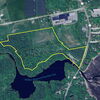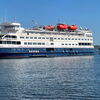Processing Your Payment
Please do not leave this page until complete. This can take a few moments.
Road warrior | An east-west highway would be a quick way to move cargo across Maine, but for Peter Vigue, it's much more than a throughway
"We call it an east-west highway, but it is much more than that," Vigue says, speaking recently from his office at Cianbro Corp. in Pittsfield at 7:30 a.m., one of the few time slots he had available. The CEO of the construction company, which booked $425 million in revenue last year, says he envisions a full-bodied, 2,000-foot-wide transportation and utility corridor that could drive economic growth in the state for the next century.
Project Manager Parker Hadlock echoes Vigue. "It's not just about building a road," he says. "It's a tool in the state's arsenal. It's about economic vitality. There's a road involved, but there's also a utility corridor, a communications corridor, and rail is also a big part of it. Clearly there is a port component, too."
Vigue's east-west highway is almost a direct shot from the Canadian border to the New Hampshire border along a remote and sparsely populated band of the state. Tentative maps of the route show a line drawn from Calais to Coburn Gore, stretching 220 miles and running through or near towns like Costigan and Brownville Junction. Laying down the road will require obtaining right-of-ways from landowners, mostly timber companies, and not snatching property by eminent domain, which can only be enforced by the government. "Pete believes the best route is from Calais to Coburn Gore," says Dottie Hutchins, the project's spokeswoman. "This would not impact communities and we wouldn't be displacing people."
The route would also take advantage of a private logging road running from Costigan to Baileyville called the Stud Mill Road. Alongside this 60-mile dirt road already lie a high-voltage line and natural gas pipeline, and the idea is to extend these carriers across the state. "The goal is to site [future electricity lines and pipelines] in one corridor so they're not crisscrossing the state," Hutchins says. "It makes sense that the corridor will be used to move power."
Stepping back a bit from the map to take in the larger picture, Vigue says the east-west corridor could provide the missing link between the Maritime Provinces and Quebec and Ontario, between the eastern ports of Halifax and Melford in Nova Scotia and the highways and railroads fanning out from Montreal to Toronto, Detroit and Chicago. Ultimately, as Canada strengthens its ports and transportation systems to better link to the vast markets of Asia, Maine could become swept into the crosscurrents of global trade.
If the east-west corridor is built, its planners see a plethora of potential goods and services coming in and out of the state, from Chinese-made products to Maine-made paper, blueberries, seafood, high-speed Internet, wind power, power generated in New Brunswick, oil ˆ even fresh water. "All we know is a lot of things will change in 50 years," Hadlock says. "And it's important to have the infrastructure in place to accept and accommodate that change."
The project, however, is faced with its share of challenges, from potential dissent from environmental groups and highway foes, to the pesky problem of lining up at least a billion dollars in private funding.
Plotting a course
The idea of a road connecting Maine's east and west borders has been around for years, perhaps going back to the 1960s. But this idea has been hindered by the intractable dilemma of how to pay for it. There's not enough in the public coffers to build a 220-mile road that will likely cost, these days, more than $1 billion. The only realistic option, Vigue argues, is a privately funded venture that promises revenue from tolls. Even then, finding backers willing to front the steep initial costs and then wait 15 or 20 years for a profit could be challenging. But already, according to those close to the project, three or four unnamed investors are showing serious interest.
Private toll highways are gaining popularity in the United States, according to Robert Poole, the director of transportation at Reason Foundation, a nonprofit libertarian think tank in Los Angeles. In testimony Poole gave to the U.S. House Committee on Transportation and Infrastructure last year, he said part of the reason for the enthusiasm was a large and yawning shortfall in federal highway funding, a deficit he pegged at about $57 billion. Maine alone had to defer more than $200 million in roadway projects between 2005 and 2007 due to money gaps.
Vigue started talking about an east-west highway in earnest about three years ago. More recently, he has stepped up the pace with meetings with railway executives, Canadian officials and other stakeholders to pin down details. Cianbro has also partnered with the Louis Berger Group, an international engineering firm in New Jersey, to conduct feasibility studies costing between $50,000 and $100,000. Those studies are examining every aspect of the project from environmental permitting and right-of-way allowances to toll and revenue forecasts.
By the end of the summer, Vigue anticipates having a core group of investors committed to the project, with the anticipation of breaking ground on the highway in 2011. After that, the pace would be rapid, with the corridor's completion date set for 2014.
Joe McKeever, who is the New Hampshire-based vice-president of the Louis Berger Group, won't disclose the identities of the interested financiers, but says the majority of them are foreign. "A lot of the investment is stimulated by the weak dollar," he says. (If Cianbro were to invest in the highway, Vigue says its stake would be "very little." And the company would not be contracted to build the road.)
For a private highway to be successful, the pricing scheme must make economic sense to truckers. In the case of the east-west highway, any truckers put off by tolls could choose the 570-mile journey from St. John to Montreal via the Trans-Canada Highway, or opt to go south through Maine and back north through upstate New York.
McKeever says Canadian trucking associations have said a $100 toll on the road would make it worthwhile to drive the east-west highway rather than loop around Maine. Driving a diesel truck for an hour costs as much as $300, according to McKeever, who calculates that the east-west highway, which also would be open to passenger vehicles, could shave two to three hours from the trip.
According to his feasibility study, between 2,000 and 3,000 trucks will use the highway per day. "And that would include recreational vehicles," McKeever says. "The tourism industry has expressed interest in using the highway, and possibly, it might be attractive to passenger vehicles."
To make sure trucks can zip right through Maine and save time, the east-west highway planners also want to eliminate border delays. Hadlock says the highway will try to become a prototype for new scanning technology allowing cargo vehicles to slip seamlessly across borders without guard checks. "When a rail car passes through the border there are no inspectors at the border, so some variation on that process for the trucking community might be appropriate," Hadlock explains. The trucks will also employ a transponder, like the E-ZPass used in Maine, and there would not be many exits or entrances to the roads, perhaps just a dozen. "It's a straight shot through the woods," Hutchins says.
Another important component of the east-west corridor will be its two intermodal stations, where containers can be transferred from truck to train, or vice versa. If the east-west highway is routed through, or nearby, Brownville Junction, it could take advantage of the town's current rail yard. Costigan would also likely have an intermodal facility because it is the first site coming off the Stud Mill Road where trucks coming from Nova Scotia cross rail lines and the state's major south-north interstate.
The feasibility studies will also site locations for wildlife passages so migration patterns of moose, deer, bear and other animals would not be completely disrupted. The animal passes will help keep the integrity of the northern woods intact, Hutchins says. "The other reason is to make the highway as safe as possible," she says.
Although environmental groups are waiting to react after the feasibility studies are publicized, Sean Mahoney, vice-president and director of the Conservation Law Foundation in Brunswick, says initially he sees both advantages and disadvantages to the project. "A potential advantage is if [the highway] were in fact to reduce the vehicle miles traveled by either the trucking industry or individual drivers," he says. But Mahoney also points out the drawback is that animal habitats and natural resources, like streams and lakes, would likely be disturbed by the construction.
Robert Kimber, a writer and environmental activist in Temple, is concerned about the infrastructure and residential development encroaching the wilderness of the north. "Projects of this kind keep diminishing that big woods experience we still have in Maine," he says.
Highway vision
The east-west highway, as Vigue sees it, will retrieve Maine from its spot at the end of the line and place the state right in the middle of global trade routes.
As Asian markets, especially in China and India, continue to expand, the shipping trade will grow as well. Within a few years, according to Canada's Atlantic Gateway initiative, the largest cargo ships will have the capacity to carry 15,000 containers, making them too large for the Panama Canal. More of these bigger boats heading for North America are expected to sail through the Suez Canal, making their first landing on the East Coast. What's more, West Coast ports are increasingly congested, enhancing the allure of less crowded points of entry on the eastern seaboard.
The Canadian government is readying Nova Scotia to become a vital gateway to international commerce. Jutting out into the Atlantic Ocean, the province harbors the closest mainland North American ports, in Halifax and Melford, to Europe and Asia via the Suez Canal. Halifax also has the deepest container port on the East Coast and is only operating at half its capacity.
If Canada is successful, an east-west highway in Maine could tap into that surge of trade coming in from the east, Vigue says. On the western side, leaving Maine from Coburn Gore, the highway would connect with routes spreading out across the United States and Canada. But first, Canada's 60-odd miles from Coburn Gore to Sherbrooke, Quebec, must be upgraded. Vigue's highway team is negotiating with Quebec officials about possibly establishing a public-private partnership to widen and improve the existing road.
Vigue says the highway could bring many opportunities to Maine and its neighbors. "It will raise up the region, the whole Northeast corridor. You need connectivity to the rest of the world."









Comments